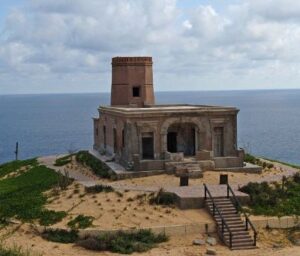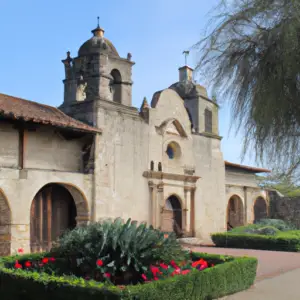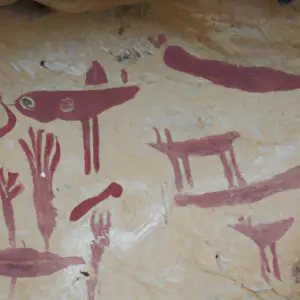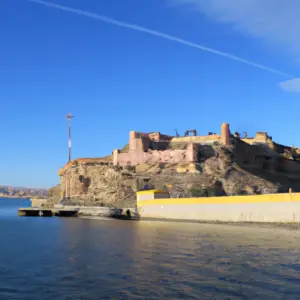10 Best Famous Monument in Baja California Sur | Historical Building in Baja California Sur

- By
- Aparna Patel
- |
- 12 May, 2023
- |
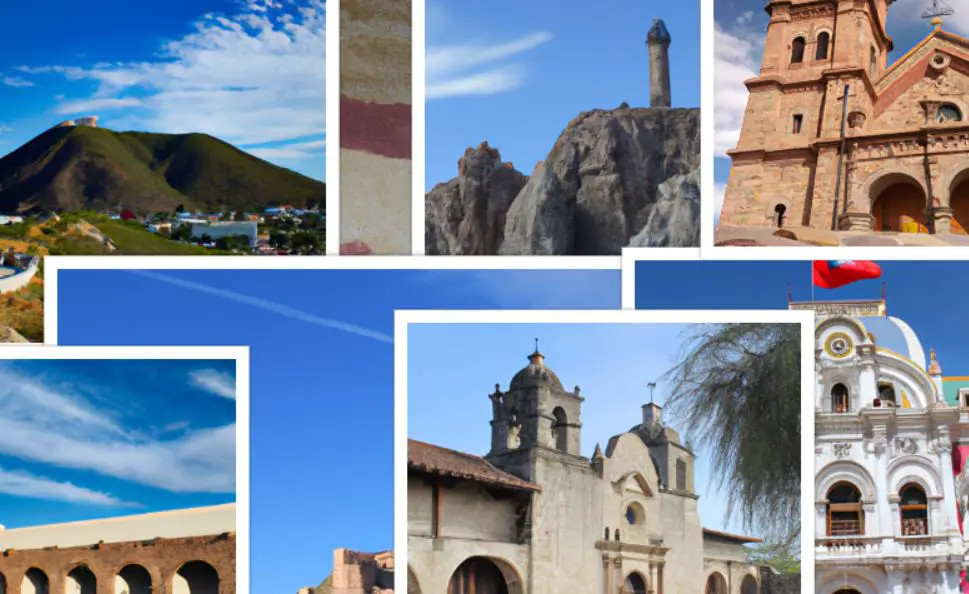
From the breathtakingly beautiful lighthouse in Cabo San Lucas to the intricately carved El Arco, Baja California Sur is home to some of the most celebrated and iconic monuments in Mexico.
From ancient ruins that tell the story of pre-Hispanic tribes to structures that shape the culture and identity of modern Baja California, this region is brimming with historical buildings and monuments that capture the imagination.
In this post, we’ll be exploring the best famous monuments and historical buildings in Baja California Sur and uncovering the stories behind them.
10 Monuments and Historical Buildings In Baja California Sur
1. Parroquia de Nuestra Señora de Guadalupe, La Paz
Parroquia de Nuestra Señora de Guadalupe is a Catholic church located in the city of La Paz, Baja California Sur. The church was founded in the late 19th century and is one of the oldest and most important churches in the city.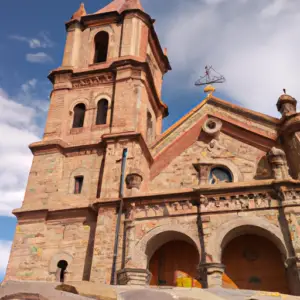
It is known for its impressive Gothic style architecture, which is the most striking feature of the church. The church is also the site of many religious events, such as the Christmas Eve Mass.
Other services provided include baptisms, confirmations, marriages, and funerals. The church also offers retreats, conferences, and music concerts throughout the year. In addition to its religious activities, the church also serves as a cultural and educational center for the community, hosting art and literature exhibitions, conferences, workshops, and classes.
2. Palacio de Gobierno, La Paz
Palacio de Gobierno is a historical building in the city of La Paz, Baja California Sur, Mexico. Located in the center of the city, it was built in 1925 to serve as the official residence of the governors of the state.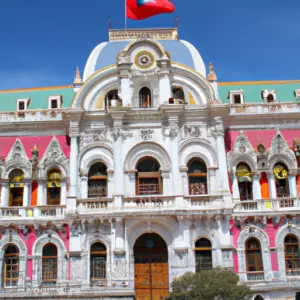
This elegant building boasts a classic architecture, with an impressive external facade made from Italian marble and sandstone.
Inside the palace are several beautiful rooms, such as the Salon de Honor, the Salon de Justicia, and the Salon de los Paisanos. The palace also houses a museum, containing artifacts, paintings, and other items of historical interest. It is a popular tourist attraction and is visited by people from all over the world. The Palacio de Gobierno is one of the main government buildings in La Paz and is a symbol of the city’s history.
3. El Faro de Cabo San Lucas
El Faro de Cabo San Lucas is a lighthouse located in Cabo San Lucas, Baja California Sur, Mexico. Built in 1992 and hence, a relatively recent addition to the Mexican lighthouses and a popular tourist attraction. It is situated on a peninsula overlooking the waters of the Sea of Cortez in the Gulf of California and stands 45 meters tall.
The lighthouse is made out of concrete and is white in color with a red-tipped tower. It is composed of a circular base, with a single tower replacing the classic lantern. Apart from being one of the tallest lighthouses in Mexico, it also serves as a panoramic viewpoint to catch glimpses of the ocean and the surrounding landscape. The light at the top works as a beacon, transmitting visible flashes every 10 seconds that are visible up to 30 miles at sea.
The structure was built to serve as a guide to the deep-water patrolled by mariners, protecting them from dangerous coasts and vessels from running into marine peril. The light that works from this lighthouse has helped sailors and other mariners to safely pass through the busy Gulf of California.
In addition to its use as a safety mechanism for navigation, El Faro de Cabo San Lucas is also a popular tourist attraction of the region. Visitors can stop by and enjoy the vast ocean views and cityscapes, or climb up to the top of the tower to admire the majestic panoramas.
4. Mission San Francisco de Borja, Loreto
Mission San Francisco de Borja, Loreto in Baja California Sur, Mexico was founded by the Spanish Franciscan Father Antonio de Barona in 1697. The mission was intended to be a base for evangelization of the natives of this region of Baja California Sur.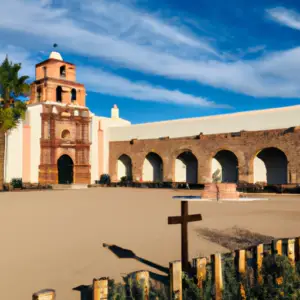
The mission and its associated ranch were a major center of activity for the Spanish in Alta California. Over the following years, the mission was expanded and improved by the friars and their indigenous helpers.
The mission complex included several buildings such as a church, monastery, workshops, and gardens. The mission actively participated in the livestock industry and fished for mollusks from ships in the nearby Sea of Cortez.
The mission experienced several moves during its lifetime, both due to changes in the political environment and natural disasters. In 1805 the mission moved to the hill where it stands today, and further changes were made in1811 when the original Mission Church was reconstructed.
In the mid 1880s, the mission was sold to private individuals and subsequently fell into disrepair. Today, only fragments of the original mission remain, but it has been declared a cultural heritage site by the local government. The mission is also part of a museum complex and various events are held in and around the ruins, such as Passion plays and Easter ceremonies.
5. Arte de Nussa, Los Cabos
Arte de Nussa is a contemporary art gallery located in the resort town of San José del Cabo, in the municipality of Los Cabos, Baja California Sur, Mexico. The gallery is dedicated to showcasing and promoting the work of emerging and established artists from Mexico and around the world.
Arte de Nussa features a variety of art forms, including painting, sculpture, photography, and mixed media, and it hosts regular exhibitions and events throughout the year. The gallery’s focus is on contemporary art, with an emphasis on innovative and experimental approaches to traditional forms.
The gallery was founded in 2016 by Mexican artist and curator, Nadia Alvarado, who is also the gallery director. Alvarado has a background in art history and has curated exhibitions in Mexico and the United States. She is committed to showcasing the work of artists who are exploring new ideas and pushing the boundaries of traditional art forms.
Arte de Nussa is located in the Art District of San José del Cabo, a neighborhood that has become known for its galleries, artist studios, and cultural events. The gallery is open to the public, and visitors are invited to view the exhibitions and engage with the artists and curators.
6. Cerro de la Virgen, San José del Cabo
Cerro de la Virgen is a mountain located near the town of San José del Cabo in the southern end of the Baja California Sur peninsula in Mexico. It is a popular destination for hiking, camping, rock climbing and other outdoor recreation. The peak of the mountain has an elevation of 848 meters (2,782 feet), making it the highest point in the state of Baja California Sur.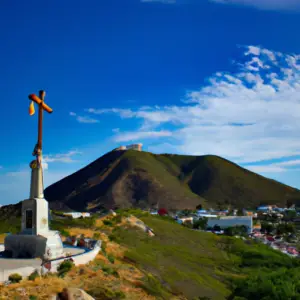
The mountain is part of a protected area, the Sierra de la Laguna Biosphere Reserve. It is home to a number of species of native plants and animals, including the endangered bighorn sheep and peregrine falcon. The summit of the mountain has a lookout platform providing panoramic views of the surrounding area.
The mountain is accessible by hiking a well-marked trail leading from San José del Cabo. The trail is challenging and should be attempted only by those with experience and appropriate equipment.
7. San Antonio Mission, Santiago
San Antonio Mission, Santiago, is located in the municipality of Mulege in the state of Baja California Sur, Mexico. It was built by the Franciscan Fathers in 1705 and was the first mission in Baja California Sur. The mission was named for St. Anthony of Padua, patron saint of the Franciscan Order.
The mission is made up of two separate dwellings, a small chapel and a convent, making it one of the largest convent complexes in the area. The exterior walls of the complex are made of locally sourced cob and stone.
The inside is decorated with sculptures, murals, and frescos. The convent is home to several pieces of furniture, tapestries and religious artifacts collected over the last 300 years or so.
Today the mission is maintained by local volunteers and is open to the public. It is a popular tourist attraction and draws visitors with its historical significance and stunning architecture. Visitors can explore the various rooms, galleries and courtyards as well as learn more about the history of the mission. Guided tours are also available.
8. Cave Painting of Santa Barbara, La Paz
The Cave Paintings of Santa Barbara, La Paz, in Baja California Sur dating back to the pre-Columbian period. It is believed to be one of the oldest murals in North America. The paintings are of prehistoric animals, humans, and different mystical figures. It is located inside a remote cave in isolated area of mountainous terrain located on the outskirts of the city. Visitors who seek to access the paintings must first obtain permission.
The paintings are estimated to date back to somewhere around 4000 to 2000 B.C. Evidence has also been found of carvings within the cave, as well as stone tools and pottery, bark and bone fragments, shells and seashells, and even large mammals. These artifacts point to anhuman presence in the area as far back as 9000 B.C.
The paintings depict various animals such as foxes, snakes, jaguars, and even a now-extinct species of porcupine, as well as different symbols associated with the people that created them.
In recent years, the cave paintings have been restored and protected and are now open for viewing. This allows for better preservation and increased exposure to the world. The paintings offer an insight into the ancient cultures that once inhabited the area and provide evidence of the technological and spiritual advancementMade by the early settlers. The area is also home to a variety of wildlife and plant life, making it a must-see destination for any interested in nature and historylike.
9. Animas Baja California Sur Museum, Comondu
The most famous museum in Baja California Sur state is the Regional Museum of Anthropology and History of Baja California Sur (Museo Regional de Antropología e Historia de Baja California Sur), located in the state capital of La Paz.
The museum is housed in a historic building that was originally a prison, and it features exhibits on the prehistoric and colonial history of Baja California Sur, including displays on the region’s indigenous peoples, Spanish colonialism, and the Mexican Revolution. The museum also has a significant collection of artifacts from the famous underwater cave paintings in the Sierra de San Francisco, which were declared a UNESCO World Heritage Site in 1993.
The Regional Museum of Anthropology and History of Baja California Sur is widely recognized as one of the most important museums in Mexico for the study of the region’s history and culture. It attracts visitors from all over the world who are interested in learning more about the rich heritage of Baja California Sur.
10. Fort of La Paz
The Fort of La Paz, also known as the Fort of San Vincente, is a historic fortification located in the city of La Paz, Baja California Sur, Mexico. It was built in the 18th century by the Spanish colonial government to protect the city from pirate attacks.
The fort is situated on a hill overlooking the city and the sea, and it was strategically positioned to provide maximum visibility and defense. Its construction was initiated in 1733 and took approximately 20 years to complete. It was built by a combination of indigenous and Spanish labor and features a mixture of European and local architectural styles.
The fort was primarily used as a military base for the Spanish colonial army, and it was also used as a prison during the Mexican War of Independence. In the mid-19th century, it was converted into a customs house and served as such until the early 20th century.
Today, the Fort of La Paz is a popular tourist destination and is managed by the National Institute of Anthropology and History. It has been restored and converted into a museum, showcasing the history of the fort and the region.
Visitors can explore the interior of the fort, which includes exhibits on the history of La Paz and the role of the fort in defending the city. The fort also provides stunning views of the city and the Sea of Cortez.
Special events are occasionally held inside the fort, such as concerts, theatrical performances and art exhibitions. There is also a restaurant and café onsite, making it the perfect spot to relax and take in the views of the La Paz bay.
Search Posts
Latest posts
-
4 Mar, 2024
Why are there no seat belts on trains?
-
4 Mar, 2024
How can I do a "broad" search for flights?
-
5 Mar, 2024
Passing through airport security with autism
Popular posts
-
5 Mar, 2024
Why prohibit engine braking?
-
5 Mar, 2024
How to avoid drinking vodka?
